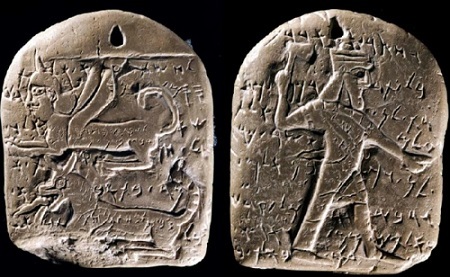

The Arslan Tash amulets also known as the lion stone was discovered at the ancient Hadatu region (in northwestern Syria), is a tablet containing the magic spell to prevent the household from the demons.
One of the greatest exciting and prominent peoples in the ancient period was the Phoenician. The Phoenician language code, their vocabulary, and their lifestyle were teleported over most of Europe and even the Near East through seaborne trade across many periods. The varied mysticism and customs of the Semitic peoples of the Near East always served as a major point of inspiration and knowledge for archaeologists and history buffs. Various remarkable pieces of artwork were uncovered as a result of research in the region's most famous ancient metropolises. Unusual and weird amulets manufactured by Arslan Tash possibly shed some light on that. The Arslan Tash amulets supported a defence against the supernatural deity, particularly night spirits, in the wider context.

National Museum of Aleppo, Arslan Tash amulet, marked as public domain, more details on Wikimedia Commons
Two chiselled limestone medallions denoting the writings “Arslan Tash 1” (“AT1”) and even the shorter “Arslan Tash 2” (“AT2”), which are also presently placed in the Museum of Aleppo, were purchased from one peasant in 1933 by Robert du Mesnil du Buisson. He issued his AT1 visuals and photos in 1939. Gypsum reconstructions of the tablets were generated by Count du Mesnil du Buisson, however, they are not any more to be found.
The little rectangular memorial was acknowledged like an amulet since this end of it possessed a hole. The lamassu, a feathered lion with a human skull and a malevolent she-wolf with only a scorpion's tail, is illustrated on the coin's front as it is preparing to eat a male or female form. The supposed beam of light is not shown; instead, a wandering god with a late-Assyrian headpiece is swinging an axe. The “AT1” limestone plaque has chants to keep monsters out of the residence as well as apologies to Heaven, Earth, Baal, Horon, and other gods.
AT2 was issued in 1971 by Mesnil du Buisson and Caquot. It exhibits “m-z-h,” a male evil. It has shorter statements across both edges that are produced in the identical vocabulary and script as the initial amulet and weighs 53 by 33 mm.
J. Teixidor and P. Amiet, who glanced at the real thing in the National Museum of Aleppo, raised questions on the amulets AT1 and AT2's reliability. Jacobus van Dijk (1992) argues in favour of the tablets' credibility. It's apparent how Dennis Pardee (1998) looks more at the incident. At this period, the consensus of academics believes the AT1 Arslan Tash amulet's provenance.
The ancient site of Arslan Tash can sometimes be found in modern-day Syria, beside the community of Ayn al-Arab, in the northern Aleppo Oblast. Hadtu was a valuable material that previously occurred in Arslan Tash. The town, which had been the capital of an Aramean kingdom, was captured by the Assyrians in the ninth century BC. Hadtu was the centre of several shifting traditions and cultures, and during the Assyrian dynasty, it continuously grew in popularity as a major city. It was situated on the left side of the Euphrates River, adjacent to the historic Hittite town of Masuwari. Hadtu had positive relationships with all the important cities. Such a town is referred to as Arslan Tash.
Q1. What is the meaning of Arslan Tash Amulet?
Ans. The Arslan Tash amulets represent talismans revealed in northeastern Syria in Arslan Tash, the territory of old Hadatu. They must have been characterised by massive treasures such as allowances from Arslan Tash. The tablets' contents are recognized as KAI 27.
Q2. Who first discovered the Arslan Tash Amulet?
Ans. Two incised limestone medallions displaying the writings “Arslan Tash 1” (“AT1”) and the lighter “Arslan Tash 2” (“AT2”) that Robert du Mesnil de Buisson owned from a peasant are currently on show in the Gallery of Aleppo.
Q3. What is the impact of Arslan Tash Amulet?
Ans. It was made to protect the owner from demons. The lengthy inscription reflects a profound mindset and the recipient's "alliance" with the galaxy, which it utilises as a judicial rationale for executing the ritual.